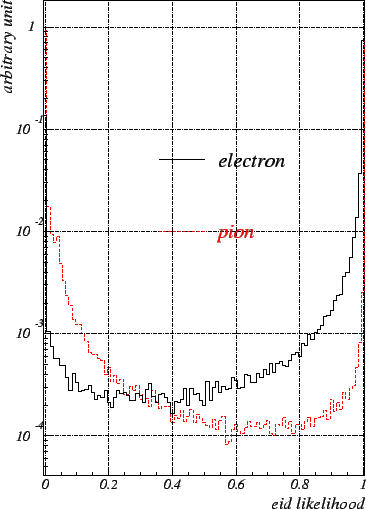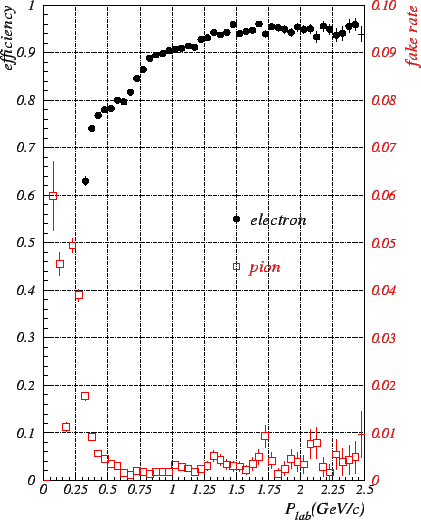



Next: KID and pion fake
Up: Particle Identification of Electrons
Previous: Particle Identification of Electrons
Contents
Electrons are identified by using the following discriminants:
- the ratio of energy deposited in ECL
and charged track momentum measured by CDC,
- transverse shower shape at ECL,
- the matching between a cluster at ECL
and charged track position extrapolated to ECL,
 measured by CDC,
measured by CDC,
- light yield in ACC, and
- time of flight measured by TOF.
We made probability density functions (PDF) for the discriminants
beforehand. Based on each PDF, likelihood probabilities are
calculated with track-by-track basis, and unified into a final
likelihood output. This likelihood calculation is carried out taking
into account the momentum and angular dependence. Fig. ![[*]](./icons/crossref.png) shows the output from the above procedure. Closer to unity the
particle is more likely to be an electron. The solid (dashed)
histogram shows for
shows the output from the above procedure. Closer to unity the
particle is more likely to be an electron. The solid (dashed)
histogram shows for  in
in
 data (
data ( in
in
 decays in data). The clear separation can be seen.
decays in data). The clear separation can be seen.
Figure:
The distribution of final unified discriminant to
identify electrons.
The solid histogram is for electrons in
 events
and the dashed one for charged pions.
events
and the dashed one for charged pions.
 |
Figure:
Electron identification efficiency (circles) and fake
rate for charged pions (squares).
Note the different scales for the efficiency and fake
rate.
 |
The efficiency and fake rate are displayed in Fig. ![[*]](./icons/crossref.png) using electrons in real
using electrons in real
 events for the efficiency measurement, and
events for the efficiency measurement, and
 decays in real data for the fake rate
evaluation. For momentum greater than 1 GeV/
decays in real data for the fake rate
evaluation. For momentum greater than 1 GeV/ , the electron
identification efficiency is maintained to be above 90% while the
fake rate to be around 0.2 to 0.3%.
, the electron
identification efficiency is maintained to be above 90% while the
fake rate to be around 0.2 to 0.3%.




Next: KID and pion fake
Up: Particle Identification of Electrons
Previous: Particle Identification of Electrons
Contents
Samo Stanic
2001-06-02

